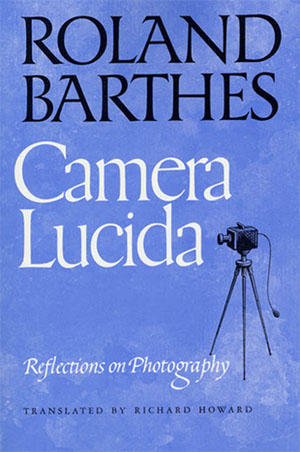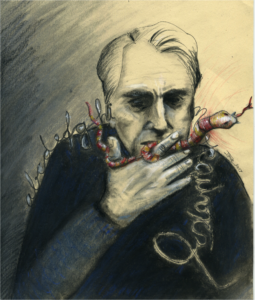Return to series Table Content | Return to VJIC Table of Content
Ione Manzali is a visual artist and researcher in philosophy of art, phenomenology, media studies and philosophy of urbanism. Has been publishing, lecturing and teaching workshops in Europe, Brazil and the USA.
A book considered his most personal and his most philosophical, La chambre claire was released by Roland Barthes in 1980, and turned out to be tremendously influential in Photography studies. Its unsystematic structure and purposely casual and intimate tone does not compromise the knowledgeable contents and the rigorous approach. Here, Barthes matured his longtime interest in Photography concentrated between 1961 and 1973, and later gathered in a collection of essays published in the USA in 1971 as Image, Music, Text. La chambre claire was his last book, he died soon after delivering the manuscripts.
 In the original title, Barthes plays a french jeux de mots, with a XIX century optical device, named in italian camera lucida, chambre claire in French, lightroom in English, calling for an inquiry on the beginnings of photography. According to mainstream Photography history, such development goes from hand drawing fleeting white reflected lines on black paper of the lightroom device, to dark lines that imprint themselves on white paper, in a darkroom. Let’s remember that Barthes did not lived to see the digital form of Photography and therefore all of his analysis deal with the analogical form. Now, if one talks about genesis, the birth of something, that one is speaking Phenomenology. Why? because Phenomenology was initiated by Husserl in order to describe how anything, any and all phenomena, come to be what they are and to provide the explanation on the way these phenomena happens as original manifestations in one’s mind.
In the original title, Barthes plays a french jeux de mots, with a XIX century optical device, named in italian camera lucida, chambre claire in French, lightroom in English, calling for an inquiry on the beginnings of photography. According to mainstream Photography history, such development goes from hand drawing fleeting white reflected lines on black paper of the lightroom device, to dark lines that imprint themselves on white paper, in a darkroom. Let’s remember that Barthes did not lived to see the digital form of Photography and therefore all of his analysis deal with the analogical form. Now, if one talks about genesis, the birth of something, that one is speaking Phenomenology. Why? because Phenomenology was initiated by Husserl in order to describe how anything, any and all phenomena, come to be what they are and to provide the explanation on the way these phenomena happens as original manifestations in one’s mind.
Right in the opening pages, our writer tell us how stricken he was by noticing himself performing a particular kind of look, a look that gazed at a specific kind of evidence, a photographic evidence, “I am looking at the eyes that looked at the emperor” (p.3). Along the book, the phenomenological intentional gaze, where meaning and image are simultaneous, is pointed by Barthes as the key to understand the nature of Photography. Barthes focus on Photography’s unique privilege of bringing back an essential connection to factuality, i.e, its ability of substantive presentification, of “bringing back the dead” by presenting traces of an absence, and with it an awareness of time, fragmentation and mortality. That particularity makes, even in legal terms, photography as evidence of an event. Well, evidence [Evidenz], is a dear term in Husserl’s Phenomenology, indicating the concretion of self-presentation [Selbstdarstellung] of an actual entity. Husserl, the creator of the Phenomenological movement, aimed in his writings to access the pre-theoretical field of consciousness by combining and overcoming both the empiricist and the transcendental schools of philosophy. Taking the traditional representation of phenomena as a secondary standing, Husserlian Phenomenology cares not what something represents or symbolizes but its essential meaning and value as guarantee for things actual presence, i.e., their truth. Truth, the génie propre of Photography is, for Barthes, the essential tract that distinguishes it from the community of images as “extended, loaded evidence” (p.115). By that he means what I would say in a formula, Photography’s truth is the truth as Photography. How so? The brief, poetical and dense text of La chambre claire is an explanation of this chiasmus.
Considered the founding father of semiotics, Barthes’ career is mostly seen as focused in textual interpretation and linguistics, in a development from Saussure’s semiology to post-structuralism, that is, post phenomenology and post existentialist French philosophy. Despite Barthes had never called himself a phenomenologist but a semiotician, and most essentially an essayist, a teacher, a writer and a lover of literature, and despite the distinction between semiotics and phenomenology, I see in him a singular phenomenologist of Husserl’s school, along the way Sartre had interpreted it, blended by Barthes with Merleau-Ponty’s phenomenological developments. Sartre, to whom Barthes dedicated La chambre claire, confronted Husserl in his 1940 book L’Imaginaire[1]. He was concerned with the description of the way a imagetic act is constructed by the intentionality of conscience, i.e., how the mental image of phenomena simultaneously builds itself in consciousness while, paradoxically, being part of the making of such act.

© Ione Manzali
If we observe Barthes linking the status of “sign” with the husserlian “thing”, La Chambre claire represents a passage from semiotics to phenomenology that is not found in his writings of the 60s. Time and again, Barthes shows in this book analogies between Husserl’s phenomenology as a method of describing original experiences and photography as means to explicit Evidenz. In the singularity of each picture, no matter how many times it is produced and reproduced, Barthes sees a phenomenological suspension [epoché]. The general positing of stuff, the “thesis of the world” that unreflectively commands our actions is then suspended, bracketed, says Husserl, and that bracketed moment is ex-posed then as a picture, suggests Barthes. Framed, frozen, reduced and presented in a given photo picture, the paradoxical repetition of the unique marks photography’s essence, and for that, says Barthes, a photo “répète mécaniquement ce qui ne pourra jamais plus se répéter existentiellement“(p.15), that is, exposes in a return of the instant to itself, the essence of the thing gazed, making each photo not an object but, after this eidetic reduction, just a trace, a ghost, a spectrum. Recognizing in a given picture the happening of the occasional and singular truth, “not… a ‘copy’ of reality but… an emanation of past reality: a magic, not an art” (p.88), Barthes sees an ontological anteriority and superiority of Photography over painting and other expressions of art. This bold statement rests precisely by Barthes realization of Photography’s non poetical or non productive aspect, and yet, for not being a kind of art, Photography brings new possibilities outside of art’s domain. In the cladding of past and present, that situates it between image and actuality, a photograph is for him an anthropological new object, a extraordinary being, yet to be precisely defined. In between real and unreal, “neither image nor reality, a new being, really: a reality one can no longer touch” (p.87), a ghostly apparition that “certifies a presence” is then his closest definition of a picture.
After interpreting photography as a sign, according to his semiotical analysis, itself on pair to a hermeneutics and a phenomenological description of reality, Barthes, on part one of his book, states that Photography as such is unclassifiable for its inauguration-character of a new entity. Facing the difficulty of the task, and the need to escape a scientific approach, Barthes proposes a narrative outside of science’s pretension of a impartial cold analysis. He introduces then his triad, Operator-Spectrum-Spectator, as more originary than the traditional aesthetic categories of artist/producer-theme-reception/public. The operator is turned into a “mediator of a truth”(p.70) and the referent into a spectacle of a “impossible science of a unique being” (p.71). Disclosing his particular cynical phenomenology, made to order to describe photography and no other, the pair Studium and Punctum are here Photography’s private categories: to inform, to surprise, to signify, to waken desire, are then, the elements of Photography’s peculiar language.
Barthes’ analogy between a mother’s body and the camera body with the darkroom processes follows closely the book’s central thread. Barthe’s mingles his semiotical analysis of the universal essence of Photography with the mourning of the recent loss of his mother. In a development, he parallels his personal loss to analytical reason’s impossibility of conceptualization of Photography. Giving up certainty but not the quest, he realizes then, that if any photo in its objectual and concrete presence discloses a presence, a referenced, precisely of what is no longer actual, no longer here, it urges to find out the vanishing point where the image and the non imagetical meet. The core of these two levels, the personal and the objective, the sublime and the beautiful, bring us immediately Barthe’s search for the most original starting point where form is shaped. Converging motherhood’s power of bringing to form and bringing-into-light (in portuguese we say dar à luz [bring-to-light] to name the act of a mother giving birth to her child) and photo making, Barthes makes an effort to understand the precise “how” the particular medium magically captures the instant and put it into a visible shape. The photographic process is for Barthes a movement related to the making of reality in consciousness out of an intentional act. For Husserl, it is in the collection of intentional acts that human consciousness dynamically structures itself, not as a substance but as dynamis.In the second part of the book, his eulogistical regressions on the memory of his mother take him to consider not the variety of photos studied in part 1 but a single photo, disclosing its main existentials: love and death. Assumedly anti-scientific and anti-universal, in his intimate account of that photo, Barthes presents “his” phenomenology of Photography:
“…in Photography I can never deny that the thing has been there. There is a superimposition here: of reality and of the past. And since this constraint exists only for Photography, we must consider it, by reduction, as the very essence, the noeme of Photography. What I intentionalize in a photograph (we are not speaking of film) is neither Art nor Communication, it is Reference, which is the founding order of Photography.” (p.77)
According to Barthes, Photography’s eidos, its essence, would be a that-has-been (p.77), explaining that “someone has seen the referent (even if it is a matter of objects) in flesh and blood, or again, in person”(p.79). Unlike a drawing, a painting or a engraving, the certainty and the establishment of a fact “without a method”, makes a photograph itself an authentication: a certificate of an actual presence, bearing testimony not on the object but on time. For that peculiarity, the experimental order of proof, says Barthes, “From a phenomenological viewpoint, in the Photograph, the power of authentication exceeds the power of representation” (p.89). The traditional exchange between the sign and the signifier, how Barthes put it, or, as Husserl would say, between noeme and noesis[2], would rests in Photography’s permanent link to its referent, the husserlian thing, turned by it into a radiant, post-mortem life, into an event.
Recognizing in Photography a bizarre medium of a new form of hallucination, Barthes anticipated many of Derrida’s developments on the role of art in a late-industrial, hyper-technological society as well as influenced several authors across the Atlantic, like Susan Sontag. Barthes’ La Chambre claire is a gift to all those interested in thinking about the essence of Photography and proper further developments at the height of his legacy for aesthetic theory and media studies have yet to be accomplished.
© Ione Manzali de Sá – 2017
[1] L’Imaginaire: psychologie phénoménologique de l’imagination by Jean-Paul Sartre.
[2] Noema and noesis are technical terms used by Husserl to designate, respectively, the thing that is thought and the act of thinking that entity.
